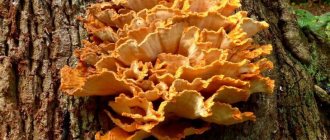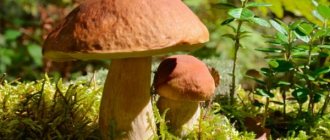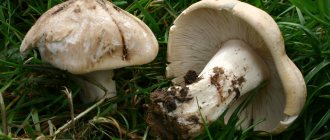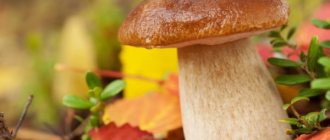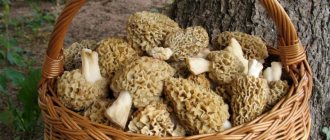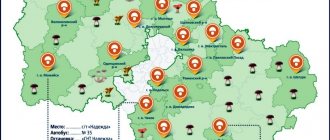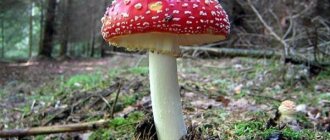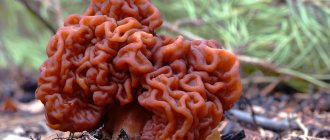What are wood mushrooms and their features
Mushrooms growing on trees are considered to be parasites, because they destroy wood and feed on useful substances. Some varieties of mushrooms prefer to grow on dying trees and stumps, while others prefer to grow only on young shoots.
The first ones, for example, honey mushrooms, are considered forest nurses, because they grow on weak, old trees. The latter are capable of completely destroying a healthy young tree in just a couple of years.
Parasitic wood fungi consume the nutrients of living plants, so they pose a real danger to any garden.
A tree on which tree parasites have settled is doomed to death. There is only a small part of the fungus on the outside of the trunk, and the main mycelium is located inside, and it is impossible to remove it from there.
Where and when do they grow?
Fungal spores are carried by the wind, and when they get inside the tree through cracks and chips in the trunk, they begin to multiply. Thus, delicious shiitake and muer grow in Asian countries (China, Korea and Japan), in the Primorsky Territory and in the Far East. The usual honey mushrooms can be found everywhere, in any forest and even in a city park.
It’s not for nothing that autumn is the mushroom season, because it is during this period that mushroom pickers begin their hunt. This applies to both ordinary mushrooms and wood mushrooms, which are found already in March and continue to grow until frost.
Tree mushrooms can be found both in the forest and in gardens and parks
There are many varieties of edible or medicinal mushrooms, such as honey mushrooms and oyster mushrooms. Mycelium grows quickly, which makes growing them at home an affordable and profitable activity.
Features of growing mushrooms on stumps and trunks
Some types of mushrooms, such as oyster mushrooms, can be grown at home, but you need to create a suitable climate for them. The ideal breeding environment is stumps from felled trees or poplar, maple, and birch wood:
- Old stumps must first be soaked for a long time in cold water, but fresh stumps can be used immediately.
- Next, you need to place the mycelium in them, for which several holes are made in the wood, about 1 cm in diameter and up to 5 cm deep. The mycelium is placed in these holes, which will have to be covered with moss, and the stumps removed in a dark, cool place.
- As soon as the mycelium begins to germinate, a wooden block or stump is planted in the soil. It is better to do this in May, when the weather is warm and the planting site should be in the shade. For each stump you need to dig a separate shallow hole (10-15 cm), the bottom of which should be covered with wet sawdust. The distance between the pits must be at least 40 cm.
- Planted stumps with mycelium are watered as needed.
Scheme for growing oyster mushrooms on stumps
There is another, easier method of growing tree mushrooms on a site using a trench.
Procedure:
- Dig a shallow, long trench.
- Sprinkle some dry barley on the bottom.
- Place mycelium on top at the rate of 300 g for each stump.
- Place damp stumps on the mycelium and sprinkle with a little soil.
Tree mushrooms can be grown on a summer cottage in trenches.
Such plantings must be regularly moistened with a spray bottle. You should not water the mycelium abundantly, because it does not like dampness. Watering is carried out only in dry weather, so as not to harm the growing mushrooms. A useful mushroom harvest can be obtained within a month after planting.
During the winter, the plantings will have to be carefully covered with straw and fallen leaves.
Autumn honey fungus Armillaria Mellea
A mushroom from the genus Honey fungus, family Physalacriaceae, which is also called Honey fungus. Strictly speaking, within this species there are two varieties, Honey and Northern, but in appearance they are so similar that we will not talk about their minor differences here.
Appearance
The cap is up to 15 cm in diameter, initially convex, later flat-prostrate in shape, sometimes even with upward-curved edges. The color of the cap varies from yellowish-brown to olive-gray tones, and on top it is covered with brownish-brown scales, denser in the center. The scales almost completely disappear with age.
The hymenophore is lamellar, the plates weakly descend onto the stalk, initially white, then yellowing and darkening to rusty brown. Spore powder is white. The hymenophore is initially covered with a dense yellowish-ochre blanket.
The leg is up to 15 cm long and up to 1.5 cm in diameter, cylindrical, often with a thickening at the bottom, colored slightly paler than the cap and also having a certain number of scales. Long black mycelial cords - rhizomorphs - often branch off from the stalk, weaving throughout the entire space adjacent to the mushroom. A ring from the blanket remains on the stem, which quickly comes off as the mushroom grows.
The pulp is thin and fibrous, light, with a pleasant taste and smell.
Living conditions
It grows from mid-July to the very end of autumn, especially abundantly from late August to late September. It bears fruit on wood of any species, including on the root system of the tree, which is why it seems that the fruiting body is growing on the ground. As a rule, it occurs in large clumps. Autumn honey fungus is a thunderstorm of the forest, as it destroys living trees with particular speed and ruthlessness.
Culinary use
Autumn Honey fungus is one of the favorite forest trophies for connoisseurs of quiet hunting; it is very tasty and suitable for all types of culinary use. This mushroom, however, is famous for its particularly dense pulp, so it needs to be cooked longer than usual - about 25 minutes. For the same reason, the legs of old specimens of the mushroom are not used for food - they become especially tough.
The effect of fungi on trees
During growth, parasitic wood fungi secrete special enzymes that break down wood into polysaccharides and cellulose, which are used for nutrition. As a result of this, the tree dies, and if it is located in a garden or park, it can infect all plantings. A tree infected with fungal spores must be cut down and burned.
Fungi that grow on trees and stumps use wood as a nutrient substrate
In addition, spores that ripen in the fall can be carried by the wind and infect healthy plants. The process of formation and growth of the mycelium inside the seedling can take more than one year, but in the end it will still lead to its death. If you want to grow oyster mushrooms or honey mushrooms on your own plot, then it is better to use old stumps for such purposes.
Mushrooms that grow under trees do not harm them. They entangle the mycelium only in the root of the plant, which serves as a source of carbon for them. In return, the mushrooms share moisture and nutrients with the tree. This symbiosis allows them to organically exist together.
Some mushrooms grow on stumps, diseased, dying trees, and plant debris. They are called saprophytes. Unlike parasites, they do not destroy trees and do not harm young seedlings.
Saprophytes - a category of fungi that feed on the remains of dead trees
Unfriendly neighbor
Some of the types of tree fungi live on already dead trunks, using decaying wood for nutrition, that is, they are saprotrophs, but most of the fungi that we see on trees while walking through the forest are parasites that exist by sucking juices from a living tree and causing decay its trunk, which, sooner or later, leads to the death of the tree.
As a rule, fungal spores fall into small cracks in the tree bark - for example, those that appear after severe frosts in winter, strengthen there, germinate and begin to spread their mycelium under the tree bark, sometimes growing several meters in different directions. So, the presence of mushrooms on tree bark is a clear sign that the tree is sick and, in the foreseeable future, may die.
List of tree mushrooms
There are a huge number of tree mushrooms, but the most common are 32 varieties. Some of them are quite edible and tasty, others are used as medicine. However, there are also extremely dangerous, poisonous representatives.
oyster mushroom
This is another name for the oyster mushroom, and it grows in multi-tiered groups on rowan or oak stumps. It grows everywhere in deciduous forests and is widely used in cooking. It has a bright pleasant taste and aroma. It has a short, dense stem, a wide cap, and the color varies from light gray to bright orange. This unpretentious species can be grown independently in a house or apartment.
Oyster mushroom can be found in deciduous forests, on oak and rowan tree stumps
Oyster mushroom
The most popular delicious mushroom, which is actively grown on farms. In nature, it is often found both on living deciduous trees (oaks, maples) and on stumps. It has an exquisite delicate taste and is widely used in cooking and folk medicine.
Oyster mushrooms begin to form in early June, and they can be collected until mid-autumn. They are horn-shaped and flat, light beige in color with white flesh. They grow in small clusters, usually high above the ground.
Oyster mushrooms are found naturally on living and dead trees.
Regular consumption of oyster mushrooms helps cope with high blood pressure and lower cholesterol levels.
It is recommended to eat healthy mushrooms for gastrointestinal diseases, as well as to stimulate brain activity. This low-calorie healthy product is used in dietary nutrition and is recommended for people suffering from allergies.
tinder
The tinder fungus looks like an unusual red growth growing low from the roots of the tree. Young tinder fungi up to 10 cm in diameter are considered edible if they are well boiled first. They are used in cooking when cooking soups, added to minced cutlets or marinated, and also used in folk medicine. This fungus parasitizes young trees, infecting them with stem rot, which leads to the rapid death of the plant.
Polypore grows in deciduous forests and parks
Trees on which tinder grows:
- chestnut;
- birch;
- oak;
- poplar;
- willow;
- nut;
- cedar;
- Linden;
- pine.
Polypores that parasitize conifers should not be eaten. At the beginning of its development, the fungus resembles a dark yellow drop of resin flowing from the tree bark. Over time, these growths increase, turning into wide plates reaching 10-30 cm in length. The edges of the cap are wavy, and the top is covered with a thin yellow fluff.
The tinder fungus, which grows on coniferous trees, is not recommended for consumption: it causes poisoning
The tinder fungus grows in large groups, in several layers, without a stem. Young mushrooms have fragile white flesh and a pleasant citrus aroma. Old large specimens have a gray cap and an unpleasant mouse smell.
Winter honey fungus
Bright red honey mushrooms breed only on dead or diseased trees, stumps, and fallen trunks. They prefer moist, shady places near water bodies or in deep ravines. They have excellent taste and do not require long-term heat treatment.
Young winter mushrooms have round, smooth, orange caps and a thin tubular stem. In older ones, the cap becomes flat, and its diameter can reach 10 cm.
Winter honey fungus is an edible mushroom that can be found on stumps or fallen trees in damp ravines.
Honey mushrooms grow in large groups, and they need to be collected from September to mid-November. Many mushroom pickers collect such mushrooms even in winter, during the thaw period, because the taste does not change at all.
Autumn honey fungus
Autumn honey mushrooms reproduce in the same way as winter mushrooms, but they prefer poplar and acacia bark. They have small light brown caps and thin legs with a small light skirt. They ripen in the fall, in September, are considered edible, and require long-term heat treatment.
Autumn honey fungus grows in groups on the bark of acacia and poplar
Coral hedgehog
A very beautiful, edible, but extremely rare species, listed in the Red Book, so it cannot be collected. Outwardly, it resembles white corals growing on dead deciduous trees (birch, oak, aspen). Only young snow-white mushrooms are suitable for food, and slightly yellowed ones are old and are not used in cooking.
The coral hedgehog is a medicinal mushroom that looks like a bush of sea coral with many short shoots
Grifola curly
The ram mushroom got its name from the original wavy shape of the cap.
Key Features:
- reproduces on the bark of maples, beeches and chestnuts;
- grows low from the ground;
- has many curly wavy caps, from a distance reminiscent of curls of lamb's wool;
- the color is yellowish-brown or gray.
Grifola curly is an edible mushroom that appears on trees in late summer and early autumn.
The total mass of the mushroom growth can reach 10 kg, and the diameter of the ram mushroom grows up to a meter. The collection begins in July and continues until the end of September. It has a delicate taste and a bright nutty aroma.
Grifola is used in folk medicine as a remedy for diabetes and nervous disorders. It relieves acute pain and inflammation, and is used for the treatment and prevention of cancer.
Chicken mushroom
The sulfur-yellow tinder fungus, or chicken mushroom, is distinguished by its bright fiery color, similar to the hot lava of a volcano. It is called so for the characteristic aroma of chicken that is released during cooking.
It reproduces in the southern regions and only on old and diseased trees. Fan-shaped caps have no legs and are attached directly to the tree trunk.
Chicken mushroom grows on the trunks of any crops and bears fruit throughout the summer
Sometimes a chicken mushroom can grow up to 10 kg, with a diameter of about 40 cm. It is eaten fried and also used in alternative oriental medicine.
Shiitake
Popular in Chinese and Japanese cuisine, mushrooms grow mainly on oak or alder bark and love high humidity. They have small round caps of a dark brown color, with edges curved inward, and short yellow legs, like a champignon.
Shiitake is eaten raw or marinated in a spicy sauce. It is recommended to be consumed as a dietary supplement to strengthen the immune system.
Shiitake is a healthy mushroom that is rich in vitamins and amino acids
In China and Japan, shiitake is grown on an industrial scale on special plantations.
Askokorine meat
Outwardly it looks like pieces of raw meat, purple-red in color. It grows only on birch stumps and consists of small plates connected by one base. This inedible mushroom has no taste or smell, looks disgusting, and contains no beneficial substances.
Ascocorine meat - a mushroom that resembles pieces of meat stuck to the trunk
Dacrimitses
The smallest and very rare type of mushroom, not used in cooking. From a distance it looks like frozen polyurethane foam, the same orange-yellow color. Prefers rotten stumps of coniferous trees and high humidity. In dry weather, dacrimitses dries out, becomes flat and hides inside the bark.
Dacrimyces mushroom can be found on rotting stumps of coniferous trees.
Exidia ferruginosa
Another inedible specimen that attacks a healthy tree, and the fungus looks like hardened epoxy resin. Its pulp is jelly-like, odorless, and can completely cover the entire tree bark. Changes shape depending on the weather.
Excidia ferruginosa is a tree fungus that looks like drops of black resin.
Bjerkandera
This is one of the varieties of tinder fungus that reproduces on rotten trees and dead wood. It grows in the form of a ribbon of caps, about 3 cm in size. The pulp is odorless, fragile and brittle to the touch. The mushroom is dark in color with a light border around the edges. It is used for food, but its taste is no different from ordinary tinder fungus.
Bjorkandera grows on dead wood, dead wood
Hypocrea
This inedible parasitic fungus appears on tree bark in the form of small yellowish spots. Over time, growing, they merge into a single whole. In the resulting spot, black dots stand out clearly, from which new fungal spores are formed.
In appearance, hypocrea resembles a dirty, dense sponge with uneven edges. It feeds on fungi from the trembling family, for example, glandular excidia, and therefore grows where its food is located.
Hypocrea is an inedible parasitic mushroom that resembles a dense sponge
Chinese muer mushroom
It grows not only in China, as the name suggests, but also in Russia, Siberia and the Far East. Widely used in oriental cuisine due to its unusual smoky flavor and delicate crispy flesh.
Mushrooms grow only on healthy but old alder and are shiny brown plates twisted in the shape of an ear. Muer is distinguished not only by its delicious taste, but also by its bright, unusual aroma.
Chinese muer mushroom is a delicious mushroom that can be found on the trunks of living trees, preferably alder trees.
Climacodon northern
Climacodon is not used in cooking or medicine, as it has an extremely unpleasant taste and smell. It reproduces on old deciduous trees, which die within 2-3 years as a result of such proximity.
It belongs to the tinder family, which is clearly visible in appearance. The light body with beige caps forms several tiers with a diameter of about 15-20 cm.
Climacodon northern - belongs to the family of tinder fungi, settles mainly on diseased trees
Kalocera adhesive
A rather rare representative of the mushroom family, growing on rotten stumps and fallen trunks. Externally, calocera looks like bright orange corals connected at the base.
Thin horn-like processes branch from above and resemble rubber to the touch. Where Kalocera has settled, no other organisms will live. Not used for food or medicinal purposes.
Kalocera adhesive is a small bright yellow mushroom that grows on rotten wood.
Fluffy Trametes
The poisonous tramethes lives on deciduous trees, most often on birch. It looks like a flat plate with jagged edges protruding from the trunk. The cap is fluffy, covered with small gray fibers, and the flesh inside is white.
The mushroom is very brittle, fragile and collapses at the slightest touch.
Fluffy tramethes can be grown on the trunks of deciduous trees
Scaly
These mushrooms, somewhat similar in appearance to honey mushrooms, grow in large groups on old or dead alder and birch trunks. There are two varieties of flakes - golden and poplar, and only the first is edible.
Scale grows in numerous groups at the foot of deciduous and coniferous trees, rotting stumps
Golden flakes have round, light brown caps and long legs that are completely covered with large scales. Only young caps are eaten. First you need to boil them, drain the water, and then you can marinate or salt them. Poplar flake is slightly darker and larger.
Ganoderma southern
A poisonous parasitic fungus that kills the trees on which it grows, causing white rot. Distributed in central Russia and Europe, and is more often found on poplar, linden and alder.
Ganoderma southern grows on poplars, oaks and lindens
It is a convex plate, 30-40 cm in diameter, growing directly from the trunk, without a stem. Ganoderma can be dark gray or brown-brown on top, while the lower part has a reddish tint. As the mushroom ages, it becomes completely black and very hard.
Piptoporus oak
It is extremely rare in Russia and is one of the most dangerous and poisonous tree mushrooms. If consumed, it can cause severe poisoning. Grows mainly on dead oak wood. In young mushrooms the cap is orange-yellow and velvety, but in older specimens it becomes brown and cracks.
Pyptoporus oak is a toxic fungus that can be found on oak trunks and dead wood.
liverwort
This unusual mushroom with a reddish-brown cap gets its name because of its dense pulp, which resembles raw liver in appearance and consistency. Its shape is very similar to the tinder fungus, and it prefers to reproduce on healthy deciduous trees, for example, chestnuts.
Liverwort is a tinder fungus that grows on trees and resembles a liver in appearance.
In cooking, only young specimens are used, which require long-term cooking.
Chaga
One of the most famous medicinal mushrooms, which is widely used in the treatment of stomach diseases and cancer. A healing tea is brewed from chaga, which strengthens the cardiovascular system and improves the functioning of all internal organs.
Chaga is a valuable mushroom, the main advantage of which is its pronounced antimicrobial and antiseptic properties.
Despite all its benefits, chaga is a parasite that lives on a birch tree for years and destroys its structure. Outwardly it looks like a semicircular lamellar growth of dark brown or gray color. The pulp is dense, but brittle, with an unpleasant smell of rot. It is not used in cooking, but this mushroom is irreplaceable as a medicine.
Trembling fucus
It is rare in nature, mainly in Primorye, where the trembler is called the “silver mushroom”. It breeds on rotten, damp wood, in the shade. It looks like a folded translucent flower and has a jelly-like consistency. It is classified as an edible mushroom, but the gelatinous flesh has no odor.
Fucus tremors is an inedible mushroom found on the stumps and dead wood of coniferous trees.
Japanese forest mushroom
The second name is kombucha, but in appearance it is practically no different from meadow champignon. In China and Japan it is widely used in medicine and cooking. It has a rounded brownish cap, a scaly, strong leg and fleshy, dense flesh.
Japanese forest mushroom is a popular biological substrate containing many beneficial properties.
Reishi Lingzhi
More often it is called the varnished tinder fungus, and it grows only on deciduous trees. It is not an edible mushroom, but due to its beneficial properties it is used in the manufacture of dietary supplements, medications, and in folk medicine.
The low, strong leg ends in a glossy wavy cap with dark stripes. Color varies from yellow to dark burgundy.
Reishi tinctures and decoctions have an immunostimulating effect and act as a powerful natural energy drink.
Reishi Lingzhi is a saprophyte that lives on deciduous trees.
Tiger Sawfoil
An edible mushroom with hard, dense flesh that grows on fallen trees and stumps. The surface of the cap is white or white-yellow, covered with dark scales. Saw leaf contains a record amount of useful protein necessary for the full functioning of the body. It can be collected from July to October.
Tiger sawfolium is an edible mushroom that has become widespread within the temperate climate zone.
Postia astringents, or Oligoporus astringents
It appears as convex growths on dead spruce or pine trunks. Snow-white caps grow directly from the bark and can have a variety of shapes. Young mushrooms secrete a clear liquid, and the pulp is bitter and not suitable for food.
Postia astringents, or Oligoporus astringents, is found in coniferous, deciduous and mixed forests
Ischnoderma resinous
Just like Postia, Ichnoderma prefers to reproduce on old coniferous wood. This poisonous mushroom does not have a stem, and its cap is round, red-brown in color with a white edging. The pulp is juicy, light brown.
Ichnoderma resinous is an inedible parasitic fungus that causes white rot on trees.
Birch mushroom
It parasitizes young birch trees and looks very much like a woody growth of irregular shape. The mushroom is covered with a black coating on top, and inside it is light yellow or beige. It is not used for culinary purposes, but is used in medicine.
Birch mushroom - a parasitic tinder fungus that is good for health
Trimella silver ear
It does not grow in mid-latitudes; it is found everywhere in the forests of Australia, Japan and China. This is a white jelly-like growth of irregular shape, similar to a transparent piece of ice. In Asian countries it is grown industrially and used in cooking and cosmetology.
Trimella silver ear is a jelly-like mushroom that grows in countries with humid and hot climates.
Oyster mushroom Pleurotus Ostreatus
A mushroom from the genus Oyster mushroom, family Oysteraceae, also known as Oyster mushroom and Oyster mushroom.
Appearance
The hat is up to 25 cm in diameter, funnel-shaped, often with rolled up edges. The color of the cap varies from light gray and yellowish to dark gray. As a rule, several caps grow together to form a fan-shaped structure.
The hymenophore is lamellar, the plates are wide and sparse, descending along the stalk, initially light, then yellowish or grayish. White spore powder.
The leg is short, up to 3 cm long, fleecy at the base, often curved, with a lateral or eccentric location.
The pulp is dense and white, with a pleasant smell and a faint anise taste.
Living conditions
It grows from September to December and tolerates negative temperatures very well. In cold summer weather it may appear as early as June. It lives on stumps or heavily weakened living deciduous trees - willow, birch, rowan and others. Extremely rare on coniferous trees. Causes yellow mixed rot of tree trunks.
Culinary use
The mushroom is very tasty when young, but older fruiting bodies become very tough, especially their stems. The mushroom is famous for its low calorie content and the content of many substances beneficial to humans, including various amino acids, phosphorus, potassium and iron.
Oyster mushroom is one of the most artificially cultivated mushrooms in the world, second only to champignon, and now they can be bought in many grocery stores. This is due to both the taste benefits of the mushroom and the ease of its cultivation - this species is very unpretentious to the substrate and conditions life.
Experienced mushroom pickers, however, claim that forest oyster mushrooms are much tastier than those grown on mushroom farms.
Can you eat tree mushrooms?
Tree mushrooms, like ordinary ones, can be edible and poisonous. The first ones can be collected and eaten, but they must be young. The latter cannot be eaten categorically. So, from grifola (ram mushroom) you can prepare a tasty and healthy soup that will help quickly cleanse blood vessels and relieve headaches.
Required:
- 300 g young grifola;
- 1 cup flour;
- 6-7 potatoes;
- bulb;
- a pair of eggs;
- 1 carrot;
- greenery;
- salt pepper.
The soup made from grifol mushrooms is very tasty and healthy.
Mix flour with water, add salt and eggs and knead a stiff dough, roll out, cut into thin strips to make noodles. Wash the mushrooms, chop them and cook in salted water for at least an hour.
Peel the vegetables, chop finely, add to the mushrooms, pepper and leave to cook for another half hour. 10 minutes before it’s ready, add noodles to the soup, and at the end of cooking, add fresh herbs. Before serving, top with sour cream.
Medicinal mushrooms, such as reishi and chaga, are used only for preparing medicinal decoctions and infusions. You cannot prepare soups or main courses from them.
Medicinal tree mushrooms
There are several varieties of tree mushrooms that have unique medicinal properties.
One of them is reishi (lingzhi), from which antitumor tinctures used in the treatment of cancer are prepared. Decoctions based on varnished polypore help to “accelerate” metabolism, strengthen the immune system, and have a stimulating effect on the body.
Reishi mushroom decoction is used to strengthen the immune system
Healing reishi tea:
- Dry the mushroom and grind it into powder.
- For 1 glass of cold water, take 1 tbsp. l. prepared powder and mix well.
- Boil over low heat for 5 minutes.
- Pour the hot drink into a thermos and leave for 12 hours.
- Drink 2 tbsp. l. three times a day, 40 minutes before meals.
Take for 3 weeks, and then take a short break and continue the course of treatment.
The inedible tinder fungus is used as a medicine that restores damaged tissues and cells of the body. Effectively destroys pathogenic microbes and bacteria.
A preparation based on beveled tinder fungus is used as a tonic.
Chaga has long been renowned for its ability to prevent the growth of cancer cells. Decoctions based on it improve the functioning of internal organs, cleanse blood vessels, and prevent the development of heart pathologies.
Chaga infusion recipe:
- Soak one large mushroom in cold water for 5-6 hours.
- Grind thoroughly and pour boiling water at the rate of 1 part infusion to 5 parts water.
- Place the resulting liquid in a cool, dark place for 2 days.
Chaga infusion is used in the treatment of diseases of various etiologies.
Take the finished infusion 3 glasses a day after meals.
Larch sponge effectively fights insomnia, stops bleeding, and helps with excessive sweating.
Medicinal decoctions of tree mushrooms are recommended for people suffering from obesity, hypertension, and diabetes.
Chemical composition of medicinal mushrooms:
- potassium;
- vitamin D;
- calcium;
- phosphorus;
- proteins;
- iron;
- chitin;
- polysaccharides;
- essential acids.
Tree mushrooms are rich in nutrients beneficial to human health
Tree mushrooms are a healthy low-calorie product that helps cleanse the intestines and speed up metabolism. Their regular use has a beneficial effect on the functioning of the brain, musculoskeletal system, and internal organs.
Criteria for distinguishing edible from inedible tree mushrooms
If you take a closer look at tree mushrooms and how they grow, you can easily distinguish poisonous specimens from edible ones.
The main differences between dangerous mushrooms:
- If a tree fungus does not have a stalk and grows directly from the trunk, then most likely it will be poisonous.
- A large, wide cap also indicates that the mushroom is inedible.
- Edible tree mushrooms do not have bright red, bright orange or brown flesh.
External differences between edible and poisonous mushrooms
Using these signs, you can easily identify dangerous poisonous specimens.
Precautions for use
It is important to understand that every medicine has contraindications. This also applies to the use of tree mushrooms for medicinal purposes. They are not given to children under 14 years of age due to their high chitin content. People who suffer from allergies or have an individual intolerance to the product cannot be treated in this way.
Purchasing dry raw materials (dried muer, chaga) requires compliance with certain rules. Before use, such mushrooms should be soaked in water for a long time and subjected to thorough heat treatment. This will destroy bacteria and enhance antioxidant properties.
Before use, dry mushrooms should be soaked or boiled several times.
You should not collect medicinal tree mushrooms on your own, as there is a risk of making a mistake that will lead to serious health consequences. In addition, mushrooms absorb harmful substances from the environment well, while store-bought ones are grown in specially designated areas.
The nutritional value
One quarter cup (7 grams) of dried black mushroom contains ():
- Calories : 20 kcal
- Carbohydrates : 5 grams
- Protein : less than 1 gram
- Fat : 0 grams
- Fiber : 5 grams
- Sodium : 2 mg
- Cholesterol : 0 grams
As you can see, this mushroom is low in fat and calories, but especially high in fiber ().
The same serving size contains small amounts of potassium, calcium, phosphorus, folate and magnesium. These vitamins and minerals are vital for heart, brain, and bone health (, , , ).
Summary:
Chinese black tree mushroom is low in fat, high in fiber and contains many essential vitamins and minerals.
Interesting facts about tree mushrooms
Edible parasitic mushrooms can be used for making soups, salads, pickling and pickling. They can be fried, stewed, or added to fish dishes as a delicious seasoning. Coral mushroom in Asian cuisine serves as the basis for hot sauces.
Coral mushrooms go well with spicy sauces
5 interesting facts:
- Woody varieties taste like seafood and are not at all like traditional mushrooms.
- Dried mushrooms must be soaked in water before cooking. At the same time, they increase in size several times.
- Tree mushrooms with hard flesh serve as an excellent material for making original crafts, jewelry, and figurines.
- Edible species grow well on wet sawdust or straw, which makes it possible to grow them at home.
- Due to their unique composition, tree mushrooms are used in the treatment of many serious diseases. Their use activates the body's protective functions and improves brain activity.
Some mushrooms, such as shiitake, are used to make effective cosmetic creams and healing ointments.
Shiitake mushroom is a component of many cosmetic products.
Fresh mushrooms spoil quickly, but dried ones can be stored for a long time, but only in a cool and dry place. Greenish or white spots indicate that the product is stale and should not be purchased.
Before use, dry mushrooms need to be soaked for a long time, changing the water periodically. They will have to cook for a long time, about 2-3 hours, and only then can they be fried. Only mushroom caps are used in cooking, and the stems are not eaten.
Despite the fact that tree fungi are considered parasites that destroy trees, their benefits are still greater than their harm. They not only help diversify the diet, but also bring significant benefits to human health.
Do you eat tree mushrooms? Which? Share your opinion about them in the comments.
Oyster mushroom Pleurotus Pulmonarius
A mushroom from the genus Oyster mushroom, family Oysteraceae, also known as Beech Oyster mushroom and Spring oyster mushroom.
Appearance
The cap is up to 15 cm in diameter, tongue-shaped, convexly spread fan-shaped, often with a thin, slightly cracked edge. The hat is painted in whitish-gray shades, noticeably yellowing over time.
The hymenophore is lamellar, the plates are thick and sparse, descending along the stalk, white. Spore powder is white.
The leg is up to 4 cm long, up to 15 mm in diameter, central or lateral, with hairs at the base, painted in off-white shades.
The pulp is elastic and thin, grayish-white in color, with a pleasant smell and mild taste. It is noticeably stiffer in the stem than in the cap.
Growing conditions
Oyster mushrooms grow from May to October on the wood of deciduous trees, especially birch, linden and aspen. It can bear fruit on both dead and living trunks.
It is also extremely rare on coniferous trees.
Culinary use
Not the most delicious, but quite a decent edible mushroom, suitable for consumption after boiling for 20 minutes. Only young mushrooms with soft and elastic flesh are used for food.



